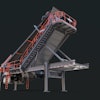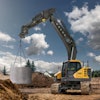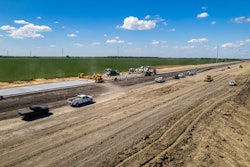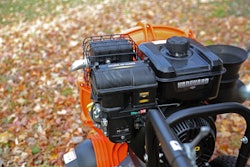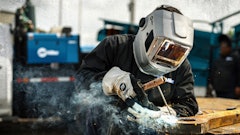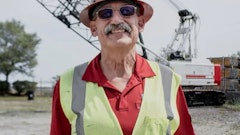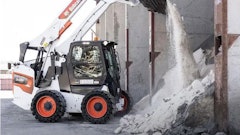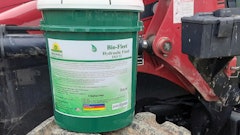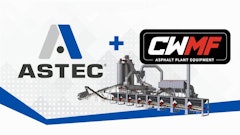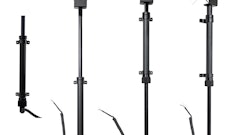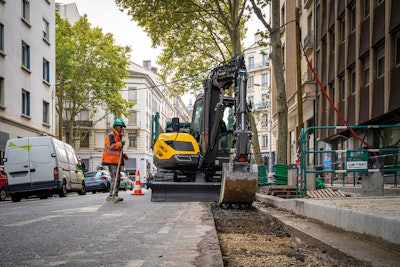
For roadbuilding projects, there’s one thing contractors can likely agree on – doing more with less is critical to maximize efficiency and profits. Tight project deadlines, limited worksite space, ongoing labor shortages and the drive to stand out in a competitive landscape demand smart solutions. In terms of an operation’s bottom line, imagine the impact of one machine that could do the job of a mini excavator, compact track loader and a telehandler. After initial investment costs, they would see significant savings in fuel, maintenance and transportation to and from the jobsite since only one trailer would be necessary. The same holds true for labor savings. Project managers could reallocate workers to other tasks to boost productivity and streamline the jobsite.
Traditionally, the risk with multitools is that they seldom deliver high-quality results across the board. They can be adequate at several functions but won’t stand out in any. Occasionally, however, something comes along that differs from the norm. This game-changing solution is the crawler skid excavator. With these machines, contractors can harness the speed and agility of a compact track loader (CTL), the maneuverability and digging ability of a mini excavator and the reach of a telehandler, all in a single machine.
There are a few standout features that allow crawler skid excavators to excel in roadwork with mobility, speed and versatility to do the job efficiently with limited equipment and crew required.
Bringing the Boom
Like traditional mini excavators, crawler skid excavators offer 360-degree cab rotation. In this sense, both the mini excavator and crawler skid excavator provide excellent space management and productivity, letting contractors dig, break or perform a number of other functions in any direction without constantly repositioning the machine. However, one significant factor limits the conventional mini excavator’s overall maneuverability — its boom.
The majority of excavators on the market today use a mono-boom design. While this configuration provides ample power for digging and other applications, its rigid nature limits overall range of motion. The main arm of a mono-boom is only able to move up and down, and the design relies on the dipper stick portion of the boom to reach, pull and dig. This limited range of motion does not prevent mono boom excavators from doing what they are made to do, but it does restrict their ability to work close to the machine and requires more room to operate.
On today’s crowded jobsites, where space is at a premium, contractors would be better served with a side-mounted, two-piece boom that offers greater compactness and range of motion. This design features an articulated arm, similar to a finger, with a total of five joints, including one between the second and third sections that allows for limited side to side motion. Bending or straightening each joint in sequence results in a boom that can extend almost straight in any direction or fold back in on itself for maximum compactness.
What does this look like on the jobsite, though? In terms of productivity, the side-mounted, two-piece boom offers an increased working envelope over mono boom excavators, while also limiting the need to reposition the machine. For example, a mono boom excavator and a similar-sized crawler skid excavator with a side-mounted, two-piece boom are both tasked with digging a roadside trench. Both machines start their trench at a similar distance. However, as the bucket works back toward the machine, the mono boom excavator must stop and reposition while the crawler skid excavator is able to continue digging — until the bucket is under the machine if necessary. By working more from a single position, contractors save time and effort while also reducing their carbon footprint.
The crawler skid excavator’s two-piece boom also needs less space to operate, opening up the use of powerful machines even in tight spaces and limiting the need for large work crews with handheld equipment or fleets of small equipment. Working against the blade with a mono boom excavator, for example, requires laying the main part of the boom almost straight out with the dipper stick and bucket folded under. This position nearly doubles the overall length of the machine and requires a lot of clearance around the excavator for working or swinging. In a situation where work is being conducted in close proximity to an existing structure or roadway, the excavator’s required footprint is too large. Examples include laying pipe, putting in sidewalks, mowing along the road or other similar applications. With a side-mounted, two-part boom, on the other hand, the bucket can be positioned directly in front of the blade or along the tracks for a compact 360-degree footprint that is only slightly wider than the body of the machine. This overall compactness is ideal for roadwork since it allows operators to dig and load trucks from a single position within a single lane, saving time, fuel and wear and tear on tracks.
Additionally, a tunnel’s low ceiling or other overhead obstacles can limit the use of mono-boom excavators, since repositioning the inflexible boom might require additional height. Using a crawler skid excavator with a side-mounted, two-part boom in the same situations, again, provides a much more compact working radius. When working in tunnels or close to overhead obstacles, the crawler skid excavator boom can open up for above grade work with only slightly more headroom than the top of the cab.
Apt for Attachments
The crawler skid excavator’s innovative boom design provides increased power and range of motion compared to other excavators, but that’s only the first part of the equation. A variety of tools for applications from material handling to trenching for utility lines allow operators to truly capitalize on the equipment’s versatility.
By angling the first part of the boom back along the cab, operators create a compact profile that maximizes lifting power and increases overall stability, resulting in a machine that, pound for pound, vastly outperforms similar-sized excavators. This design allows for the use of larger skid steer buckets — up to .98 cubic yards (.75 cubic meters) — and enables the crawler skid excavator to operate as a CTL or skid steer as well as an excavator. The boom design also allows for the loader bucket to be braced against the blade for applications such as grading and ground leveling. This innovative feature stabilizes the bucket, distributing the forces to the frame of the crawler skid excavator and reducing stress on the boom, prolonging component life.
Switching out the bucket attachment for a set of forks, the crawler skid excavator essentially becomes a highly maneuverable material handler. Unlike mono-boom excavators, the two-part boom provides a greater range of motion while maintaining level forks. With a reach of around 14.5 feet for six-ton class models and up to 18 feet for 10-ton class units, contractors can rely on the crawler skid excavator in a variety of situations, reducing the need for additional equipment, such as a telehandler. Here again, the dexterity of the boom provides a unique advantage since a fork-equipped crawler skid excavator can reposition the pallet left or right without moving the whole machine, unlike a telehandler.
The true beauty of using the crawler skid excavator as a material handler, though, is its ability to easily place material below grade. Using forks or a lifting hook, the crawler skid excavator can retrieve pipe, stone or other materials from the staging area, quickly and safely transport them to the work area and place them exactly where workers need them. There’s no need for wheelbarrow brigades, manually loading or unloading pallets or other time and labor intensive methods.
However, optimizing efficiency when it comes to attachments relies not only on the boom, but also the quick-coupler. Some advanced systems allow operators to quickly transition between attachments without leaving the cab, decreasing downtime between tasks and increasing overall productivity. Being able to use attachments in reverse is also key to increasing versatility. This feature ensures buckets and other attachments are in the ideal position for the job at hand, taking full advantage of the crawler skid excavator’s extended range of motion.
The Right Speed
With the right suite of attachments and a cutting-edge quick-coupler, a crawler skid excavator is ready to take on any application. However, different jobs come with vastly different speed requirements. To offer a suitable replacement for an excavator, CTL, skid steer or other equipment, a crawler skid excavator must also provide the speed to effectively perform these tasks.
For the majority of operations, the crawler skid excavator’s speed can provide a significant boost to productivity and efficiency. Some models are capable of speeds up to 6.2 mph (10 km/h) — twice that of a mini excavator and on par with most CTLs on the market. Given that approximately 15% of an excavator’s time is spent traveling around the jobsite, being able to get from point A to point B in half the time means work can start sooner and proceed more quickly.
But sometimes slow and steady is what’s required for high-quality results — in ditch clearing, sweeping or snow removal applications, for example. To help operators focus on the job at hand, rather than constantly worry about maintaining the ideal speed, a speed management system is necessary. Here again, innovative manufacturers have provided game-changing technology that allows crawler skid excavators to excel. These units feature an advanced speed control system that acts as a limiter, keeping the machine at the desired speed even with the throttle wide open. Operators simply select a desired top speed to best suit the job at hand. Some systems offer up to 20 speed settings for maximum versatility. In this way, an operator can easily perform, say, a flail-mowing job at minimum speed then switch to a digging bucket or loader bucket and zip around a construction site at top speed.
Kings of the Road
For complex, space-restricted roadwork, the need for adaptable, highly productive equipment continues to grow. Crawler skid excavators directly meet this demand with a powerful combination of versatility, compactness and performance. Replacing multiple machines with one simplifies logistics, cuts costs and increases productivity to revolutionize the jobsite. While staying in a single position, a crawler skid excavator can dig and then swing up and dump into a truck within a compact 9-foot radius. With a range of attachments available, these machines can be tailored to fit the specific requirements of any roadbuilding project. Utilizing the crawler skid excavator can pave the way for a smarter method for roadwork and make an operation stand out as an industry innovator.

